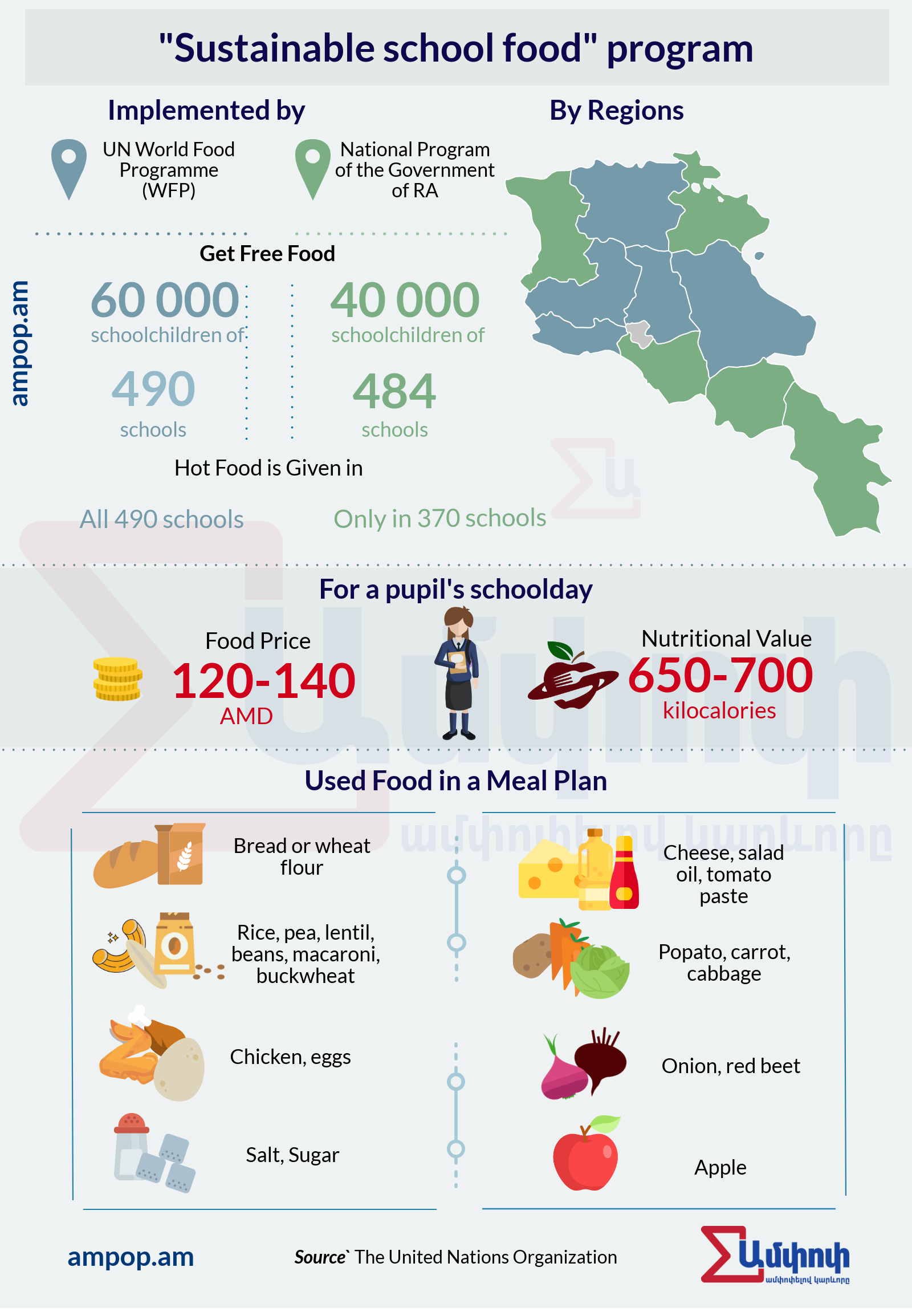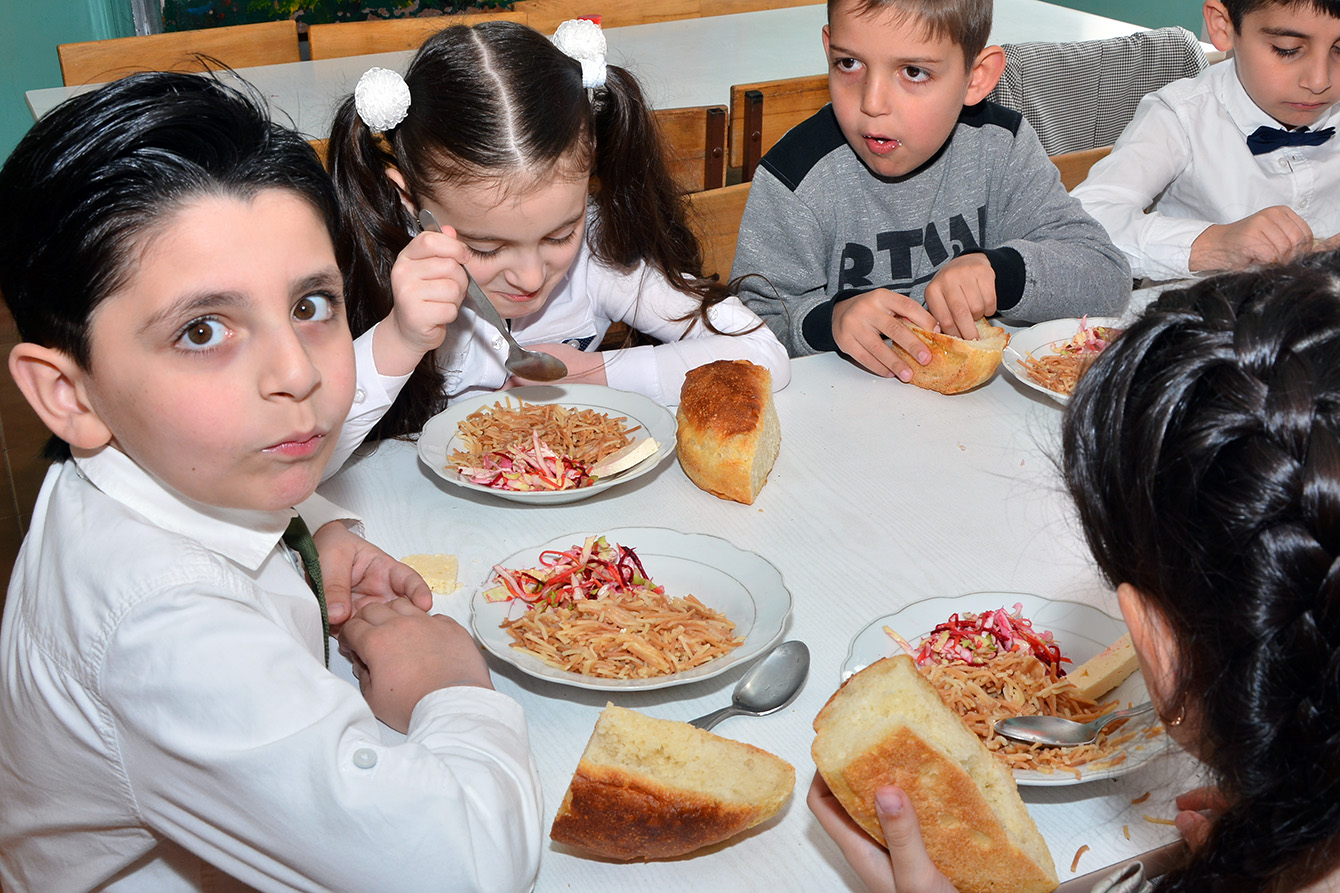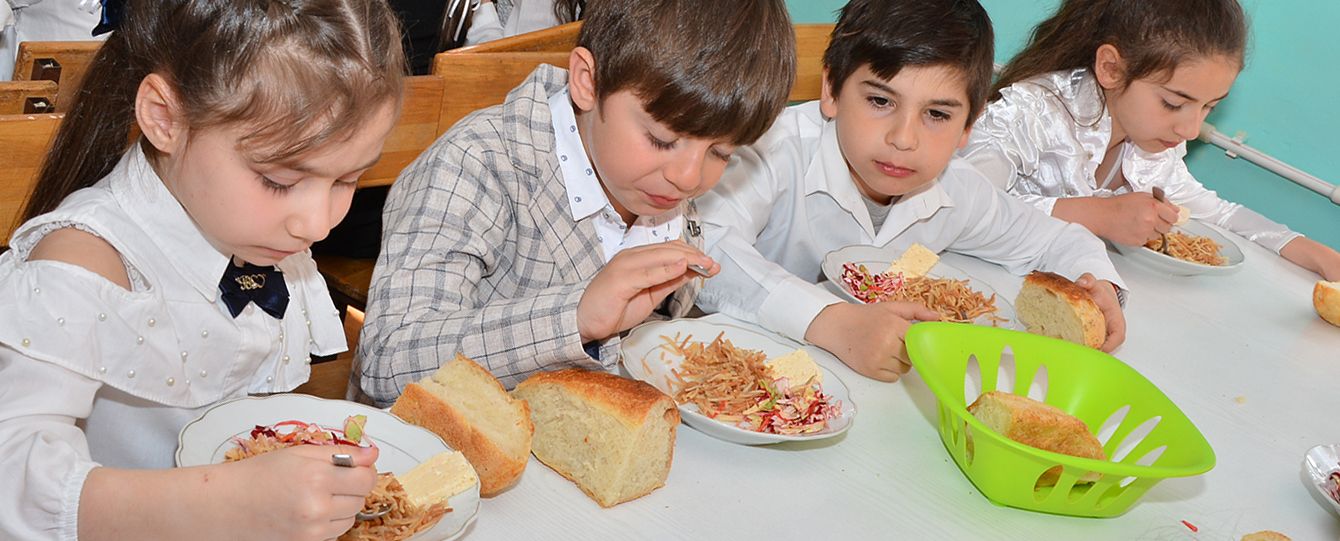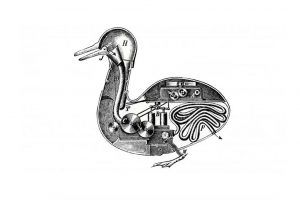About 100,000 primary pupils (pupils of 1-4th grades) of 974 general education institutions in Armenia get free food once a school day. And if there are preschools in those institutions, their pupils also make use of the same food.
Free food is provided within the framework of “Sustainable school food” program. Taking into account the above mentioned data, it leads to the conclusion that that 70% of 1374 state schools is already involved in the program. According to the Minister of Education and Science Arayik Harutyunyan the program will expand and be continuous as professional assessments state that it contributes to raising the efficiency of pupils’ education.
“Sustainable school food” program launched still 9 years ago within the framework of the UN World Food Programme (WFP). At the initiative stage, 147 schools of Armenia were involved in the program. At current the UN WFP provides free feeding of about 60,000 schoolchildren of 490 schools from 5 regions (Aragatsotn, Gegharkunik, Lori, Armavir, and Kotayk). Free food of 484 beneficiary schools is provided by the National Program of the Government of the Republic of Armenia. From the 2019 state budget more than 902 mln AMD was allocated on this purpose.
Schools where the program is carried out by the UN WFP, the Russian Federation finances it. However, it is envisaged to pass the program management gradually to the Government of the Republic of Armenia till 2023.
According to the program coordinators, all the beneficiary schools are located in regions, but at the next stage schools of the capital will take part in the program, too.

Meal Plan
The meal schedule of pupils is at the disposal of school administration and cooks, but there is a control over it. The school day food of each pupil should include 650-700 kilocalories, which make 40% of the daily intake. The food cost (basic funding) of each pupil’s school day is 120-140 AMD.
Schools are provided with recipe books which include hundreds of recipes. So each school prefers which dishes should be served. Menu of the next day is already approved by the director the previous day.
In the schools of National program the right to acquire food belongs to the school administration in accordance with the RA law “On Procurement.” In the schools where the program is carried out by WFP, one part of the procurement is organized by the Armenian office of the program, and the other part – by schools.
Nevertheless, when making menu, both schools of WFP and National program should base on the Health Minister’s order. This way both requirements of pupils’ feeding organization and the list of forbidden food are set.
There is also control over food proportion per day, energy value and quality of gained food. The health care provider of the facility is responsible for the above mentioned.
The State Service for Food Safety is responsible for this process so that the food is prepared and all safety rules are maintained. That’s why first of all schools should be provided with all the necessary conditions of catering service to become a beneficiary school.
An Example of one School
Kitchen working conditions and technical equipment of Gyumri school №7, which is included in the program, meet the needs of 587 primary pupils and 74 pupils of pre-school for hot meals.
“The greatest majority of schoolchildren eat with pleasure and that’s natural, as the food is of high calorie,”says director of Gyumri school №7 Gagik Karapetyan in the interview with “Ampop Media.”
Karapetyan also mentions that besides solving a social problem, it also creates a culture of having a meal at an exact time.

In order not to interrupt the lesson and all the beneficiary pupils manage to get the school food, in Gyumri school №7 they are guided by a pre-compiled schedule.
By the way, since October, 2018 management of “Sustainable school food” program in all 147 schools of Shirak region passed to the Government of RA. The vast majority of them – 133 schools, have a repaired kitchen and the necessary equipment – refrigerator, gas cooker and so on.
To make school feeding program as effective as possible, “Sustainable school food” foundation was also set up, which has been training school directors and cooks since 2017. 1011 directors and cooks of about 500 schools in Syunik, Vayots Dzor, Ararat, Tavush, Shirak and Aragatsotn have already been trained.
Head of “Sustainable school food” foundation Bagrat Yesayan highlights the training of school directors, too, as effective allocation and outgo of the state budget depends on them.
“During the trainings, directors are informed how to organize the procurement process and provide food security,”says Bagrat Yesayan.
According to the foundation director, providing pupils with hot meals within the framework of the program is one of their main aims. Only 370 schools out of 484 of the National Program are currently provided with hot meals. “We should try to create conditions for hot food in the rest – 114 schools as soon as possible, as its efficiency is higher,” says Yesayan.
Education expert Serob Khachatryan does not put under suspicion success of the program. “It is a very good and important program for Armenia as the provided food in other canteens has not only poor quality, but also is unavailable for many pupils. But “Sustainable school food” program gives an opportunity to get both healthy and free food,”he says.
Alongside with positive points, the expert also mentions drawbacks of the program: “In some schools canteens are small but pupils more, and a question arises how to provide everyone with food within a 5-10 minute break. I know in some cases it is done at the expense of lesson.”
Khachatryan thinks that the program will work fully if there is a half-hour break during the school day. “But in its turn it will cause other problems, e.g. heating cost will increase in winter,”he says.
The program will be more effective if canteen employees get normal salary. Serob Khachatryan assures that if the cook gets enough money, he will make a tastier food.
Story by Lilit Poghosyan
Infographics by Gayane Melikyan
Translated by Mary Grigoryan
Responsible editor Suren Deheryan
Photos Courtesy Of Gyumri school №7
For Armenian original CLICK HERE
© The copyright of stories and visualizations on Ampop.am belongs to “Journalists for the Future” NGO. It is forbidden to use Ampop’s content and images without active hyperlinks to the source website. Uploading of infographics and images of Ampop.am is possible only in case of an agreement reached with JFF.
Փորձագետի կարծիք
First Published: 09/05/2019









